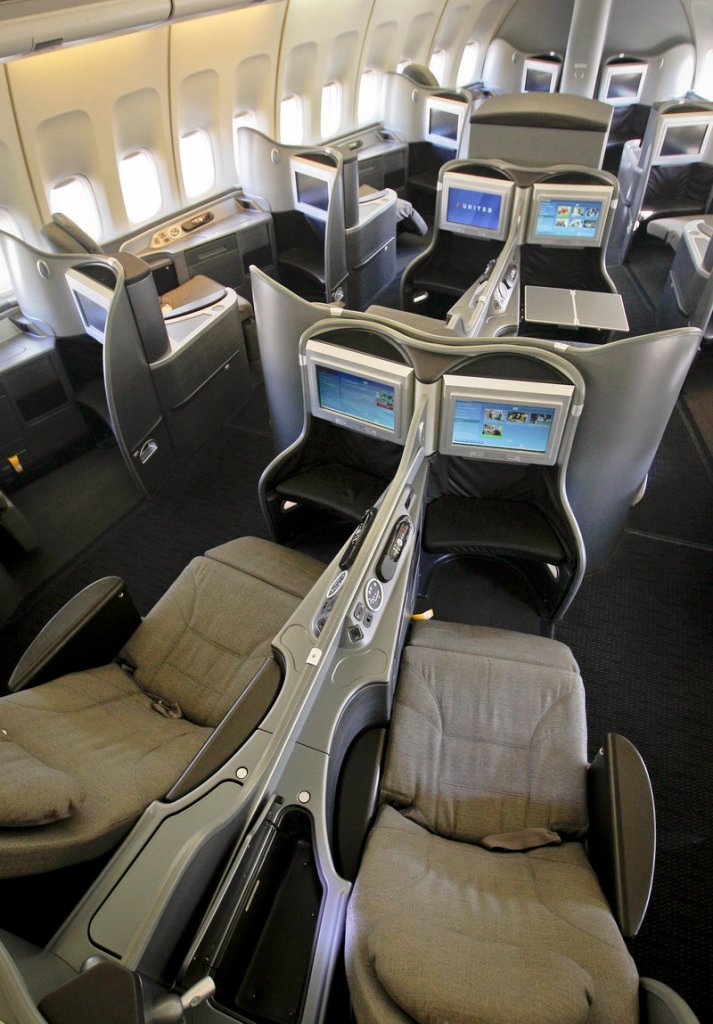NEW YORK – Flying has never been so good — for those able to splurge.
While most Thanksgiving travelers will fight for overhead bins and go hours without a snack or room to stretch their legs, life in first class is stress free. It’s always been a special place on the other side of the curtain. Now, it’s getting even cushier.
U.S. airlines, profitable again after a disastrous decade, are spending almost $2 billion to upgrade amenities for their highest-paying customers. On the most profitable international routes, high fliers are being treated with preflight champagne, flat-screen TVs and seats that turn into beds. Flight attendants greet them by name, hang up jackets and serve meals on china.
The lavish treatment is meant to keep people like Tim Carlson happy. Carlson, the chief financial officer of a semiconductor materials company, has taken 189 flights in the past two years, traveling 353,176 miles on United and its partners.
After the pilots, Carlson might just be the most important person on the plane. United will do anything to make sure another airline doesn’t steal his business. Agents call him about delays and reroute him so he doesn’t miss meetings.
“I go to the top of the list for the next flight,” he says.
On a recent trip from Newark, N.J., to Brussels, he was met at the curb with a boarding pass and escorted to the front of the security line. Four minutes after being dropped off, he was past the checkpoint.
Most of the 3.4 million Americans expected to fly this holiday week won’t get anything close to that treatment. They’ve paid a little under $400 for their round-trip tickets. And it’s a cutthroat business. To save $5, passengers are likely to choose another airline.
So, it’s no surprise that the most loyal customers, and those willing to pay more for better services, are the ones airlines want to reward.
First-class and business-class passengers make up only 8 percent of international travelers but account for 27 percent of revenue, according to the International Air Transport Association. While a round-trip coach ticket between Chicago and Beijing might run $1,000, business class costs $4,000 and first class $12,000.
“There is a war going on for the profitable passenger,” says Henry H. Harteveldt, co-founder of the travel firm Atmosphere Research Group.
“They’re now realizing that they need to offer a competitive product to attract the highest-dollar passengers,” says Gary Leff, co-founder of frequent flier site MilePoint.
On foreign airlines, the good life is even better. Emirates Airlines first-class passengers can shower on its Airbus A380s, and walled-off suites come with minibars. Lufthansa has a separate terminal in Frankfurt for its first-class passengers, but it’s hardly an inconvenience: Passengers get dedicated immigration officers and are driven to their plane in a Mercedes-Benz S-Class or Porsche Cayenne.
Singapore Airlines trains flight attendants how to walk without waking passengers. And at Virgin Atlantic’s London lounge, passengers can play pool, get a massage or relax in the sauna.
For a brief moment in the 1960s and ’70s, flying was glamorous for all. Passengers dressed up for the occasion. Planes had piano bars, and flight attendants — hired for their looks — wore tight miniskirts. But tickets cost significantly more.
By the end of the 1970s, the royal treatment was gone. Planes started to resemble crowded buses. In the decade following 9/11, any perks that were left vanished. Airlines faced new security-related costs, higher fuel prices and two recessions. They just wanted to stay in business.
That’s why most travelers have seen free meals, leg room and blankets stripped away. Even the front of the plane became stale. Foreign airlines took advantage and courted U.S. travelers with new, fancy first-class and business-class cabins.
Now, U.S. airlines are catching up. They finally have some spare cash, and as they buy new planes, they have a reason to upgrade the interior design. Engineers have even found ways to let seats go flat without requiring more space.
Send questions/comments to the editors.



Success. Please wait for the page to reload. If the page does not reload within 5 seconds, please refresh the page.
Enter your email and password to access comments.
Hi, to comment on stories you must . This profile is in addition to your subscription and website login.
Already have a commenting profile? .
Invalid username/password.
Please check your email to confirm and complete your registration.
Only subscribers are eligible to post comments. Please subscribe or login first for digital access. Here’s why.
Use the form below to reset your password. When you've submitted your account email, we will send an email with a reset code.